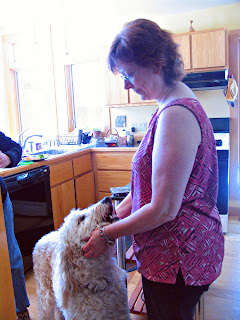But at some point I started to feel like I was copying out of her book too much. Not that I was doing so to the point of infringement or breaking some sort of artist moral code, but more...well...to the point of boredom. I am sick of little dot beads. There. I said it. I am tired of earrings which are a sandwich of a dot bead with silver rondelles and silver balls on a silver hook. Blah.
Well, ok, these poked dot beads in 'Leaky Pen' are not boring, although the bubbles are not exactly centered....
But......I still needed some inspiration. Something not out of a book, but something real that makes me stretch to adapt it into a bead.
I am in docent training at the Corning Museum of Glass, which means that in a few short months people will actually trust me to give them tours of the museum. The first exhibit we studied was Ancient Glass, which contains some gorgeous examples of nearly 4 thousand year old core formed vessels. Let me see if I can lift a picture or two of them....
I love these little vessels!
So the technique is core forming, where a clay core the size and shape of the interior of the vessel is shaped on a metal rod . Back in the day the clay was mixed with dung (camel poop) to make chipping it out of the bottle easier. Today people use steel wool covered in clay bead release, although core forming vessels is not really a popular way to make glass anymore. The glass is then wound around this core, then decoration applied. The most common decoration for these core formed vessels seemed to be stringer wrapped around the vessel and raked. To rake stringer you just heat the area molten and then drag a metal tool through the stripes to make zig-zags. Much like you might drag a knife through cream on the surface of one of those fancy coffees, or when making chocolate.
I didn't want to jump into bottles right away, so the first thing I started was raked stringer on tube beads. Getting stringer that thin however is challenging. Well, I should say USING stringer that thin is challenging. It is easy to make. But it tends to go from 'too cold to stick to the bead' to 'so hot it balls up' in about a millimeter difference from the flame. In other words it is tricky to apply. I started with plain stringer and the results were not terrible but not great either. Luckily the raking was easier. I made tube beads,circled the beads with stringer and raked from end to end so I was working on a relatively flat surface. I thought for my first attempt at raking stringer they didn't turn out too bad.
I think next I will try to make a complex stringer with stripes of the colors in one thicker stringer. I will make a flat rectangle on the end of a rod, paint stripes end to end, then stretch the rectangle so I have a long rod of stripes. Then I can apply 2-3 of these to the vessel or bead rather than 6-9 separate stringers for the same affect, and the thicker stringer will be easier to apply.
I chose colors which were similar to the old vessels: turquoise, lapis (deep blue), white and yellow. They aren't popular jewelry colors, but they certainly make me think of Egyptian decoration.
So after making a few of these I got brave and tried a little vessel. I thought it turned out wonderful for my first try, until I took it off the mandrel. Unfortunately it broke into 3 pieces. My hubby wanted to glue it together, but I think I will keep it in pieces. It will remind me that while I apply the handles and spend 3 minutes working on one end of the vessel, I must remember to go back and warm the other end occasionally. I also just got it out of the bag to take a picture of it and one of the handles had popped off as well.
Ok, so pretty sad for my first effort. But failure is a learning opportunity, right?
So as Moo would say, if at first you don't succeed.....
look really, really cute.


















































 She painted on the edges of this one...and has a button with polka dots!! I may have to try to make one of those in glass.
She painted on the edges of this one...and has a button with polka dots!! I may have to try to make one of those in glass. 

